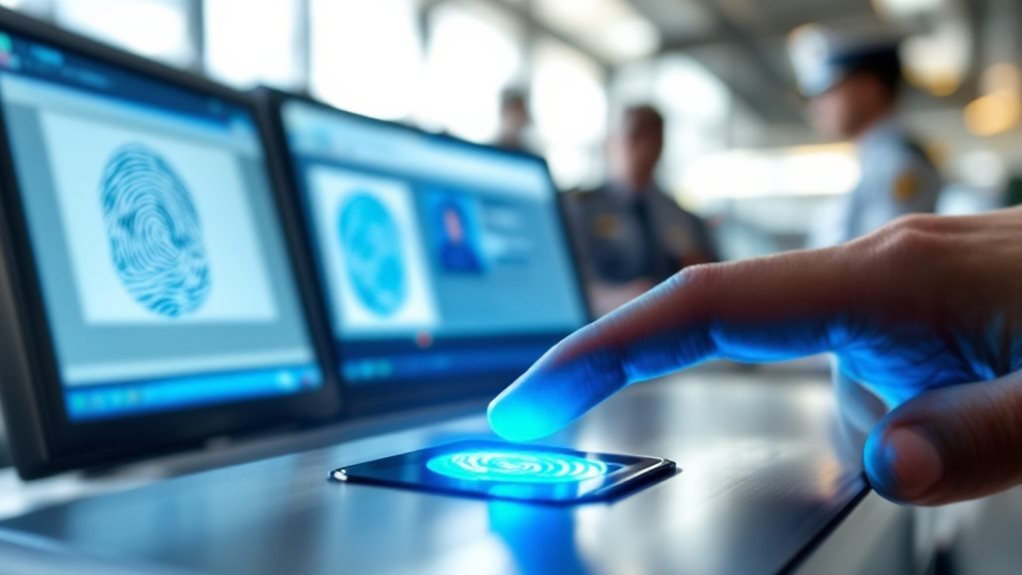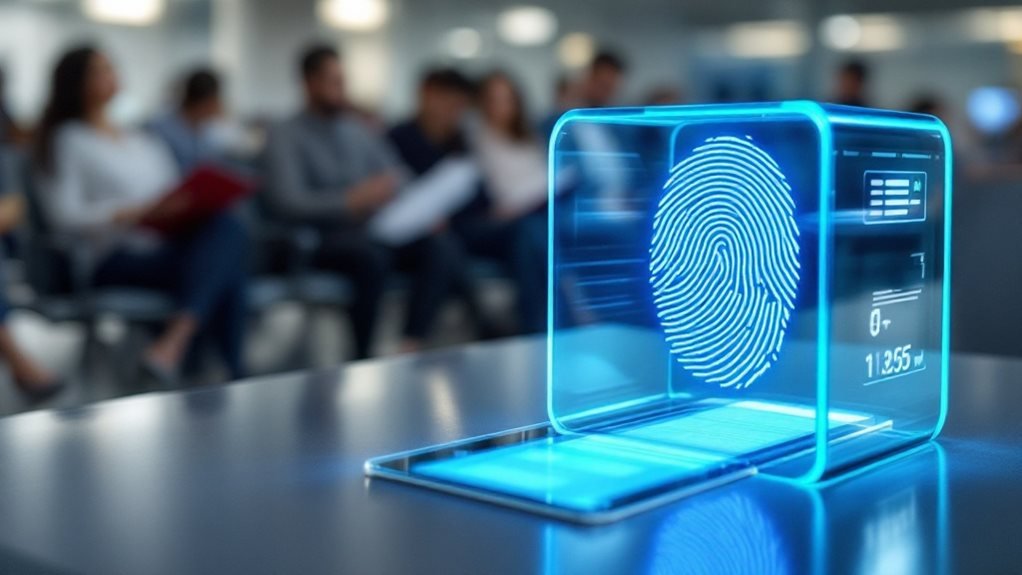Fingerprinting in immigration background checks, play a crucial role by serving as a unique biometric identifier that helps verify your identity and protect against fraud.
You’ll need to submit your fingerprints at an authorized facility, where digital scanning technology captures and stores your prints in secure federal databases.
The process has evolved from traditional ink methods to advanced digital systems that provide immediate verification and enhanced security.
Your fingerprints remain valid for 15 months and help guarantee national security by flagging any criminal records or deportation orders. Understanding this pivotal step will open the path to a successful immigration journey.
Key Takeaways
- Fingerprints serve as unique biometric identifiers that prevent identity fraud and verify applicants during immigration background checks.
- Digital fingerprint systems enable immediate verification against FBI and immigration databases to identify criminal records or deportation orders.
- Federal law mandates fingerprinting for most immigration applications, with prints remaining valid for 15 months after collection.
- Digital fingerprint collection methods, including optical scanning and live-scan technology, ensure accurate and efficient background checks.
The History Behind Immigration Fingerprinting
Immigration fingerprinting emerged in the early 1900s as the United States government sought more reliable ways to track and identify immigrants entering the country.
You’ll find that the Historical Development of this practice gained momentum after Congress passed the Immigration Act of 1924, which introduced stricter controls on immigration.
The Fingerprint Integration process became standardized in the 1940s when the FBI established a central database for immigrant fingerprints. This system helped prevent fraud and maintained accurate records of those entering the country.
Throughout the decades, you’ve seen the evolution from ink-based fingerprinting to today’s digital scanning technology. What started as a basic identification method has transformed into a sophisticated system that connects with international databases, enhancing security measures and streamlining the immigration process.
Fingerprinting in Immigration Background Checks
Modern digital fingerprint collection employs two primary technologies: optical scanning and capacitive sensing. When you visit an immigration office, you’ll encounter fingerprint scanners that capture your unique prints within seconds. These devices create high-resolution digital images that are instantly converted into encrypted data for fingerprint storage.
| Collection Method | Key Features |
|---|---|
| Optical Scanning | High resolution, Live capture |
| Capacitive | Fast processing, Direct digital |
| Live-scanWhat Are The Advantages Of Live Scan Fingerprinting Over Ink Fingerprinting? | Real-time verification, No ink |
| Mobile Capture | Portable, Field operations |
You’ll find that today’s collection process is quick and clean, without the messy ink-and-paper methods of the past. The digital systems automatically check print quality and request immediate rescans if needed, ensuring accurate records for your immigration background check. The encrypted data remains secure in specialized databases that only authorized personnel can access.
Security Benefits and Identity Protection

Why do fingerprinting systems play such a crucial role in immigration security? Your unique fingerprints serve as an unforgeable key to your identity, ensuring biometric integrity throughout the immigration process.
When you submit your prints, you’re establishing a verifiable record that prevents identity theft and fraud.
Identity verification through fingerprinting protects both you and national security interests. You can’t lose or forget your fingerprints like you might a password, and they can’t be stolen or duplicated effectively.
The system helps catch individuals who’ve previously been deported or have criminal records, while simultaneously protecting legitimate applicants from identity theft. If someone tries to use your identity, their fingerprints won’t match your records, immediately flagging the attempted fraud.
Legal Requirements and Compliance
Federal law mandates fingerprint collection for most immigration applications and petitions.
You’ll need to obtain formal authorization from USCIS before proceeding with your fingerprinting appointment at an approved facility. This process guarantees compliance with immigration regulations and helps maintain national security standards.
When you submit your legal documentation, you must include proof that you’ve completed the fingerprinting requirement.
The law requires fingerprints for various immigration benefits, including green card applications, naturalization, and work permits. If you don’t comply with these requirements, USCIS will likely deny your application.
Remember that fingerprint records remain valid for 15 months from the date of collection.
You may need to schedule new fingerprinting if your application process extends beyond this timeframe. Always maintain copies of your fingerprinting receipts for your records.
Common Concerns and Privacy Issues

Throughout the immigration process, many applicants express concerns about their fingerprint data’s security and privacy. You’ll want to understand the biometric risks associated with fingerprinting and how agencies protect your information from data breaches.
| Concern | Risk Level | Protection Measure |
|---|---|---|
| Data Storage | High | Encryption Systems |
| Third-party Access | Medium | Access Controls |
| Identity Theft | High | Secure Databases |
| Unauthorized Use | Medium | Audit Trails |
When you submit your fingerprints, they’re stored in government databases with strict security protocols. While no system is completely immune to breaches, immigration agencies implement multiple safeguards to protect your biometric data. You’ll find that your fingerprints are only accessible to authorized personnel and can’t be shared without legal authorization. The government must also notify you if there’s any compromise of your personal information.
Frequently Asked Questions
How Long Are Immigration Fingerprint Records Kept in Government Databases?
Your immigration fingerprint records will stay in government databases permanently under current Immigration Standards and Retention Policies. Even if you’re denied entry, they’ll keep your prints indefinitely for future reference and security purposes.
Can Medical Conditions Affect the Quality of Fingerprint Scans?
Yes, certain medical conditions can affect your fingerprint quality. If you can’t provide clear prints, you’ll need to request biometric exceptions or fingerprint waivers. Common issues include skin conditions, arthritis, and chemotherapy effects.
What Happens if Fingerprints Are Repeatedly Rejected During the Scanning Process?
Picture your fingertips pressing repeatedly against the scanner’s glass. If you’re facing rejected prints, you’ll need fingerprint resubmission. You can request alternate methods like name-based checks or get help from fingerprint specialists.
Are Children Required to Provide Fingerprints for Immigration Purposes?
Your child’s fingerprinting requirements depend on their age. Children under 14 typically receive automatic child exemptions, while those 14 and older must provide prints. You can request fingerprint waivers in special circumstances.
Can I Request Copies of My Immigration Fingerprint Records?
You’re in luck! You can request your fingerprint documentation through a Freedom of Information Act (FOIA) request. Contact USCIS for accessing archives of your records, though it may take some time to process.
Conclusion
Like Sherlock Holmes searching for clues, you’ve now uncovered the critical role fingerprinting plays in modern immigration. You’ll find that these unique patterns, as distinct as snowflakes, help maintain secure borders while protecting identities. Whether you’re applying for a visa or permanent residency, understanding fingerprinting requirements lets you navigate the process confidently, knowing you’re part of a system that safeguards both nations and individuals.

